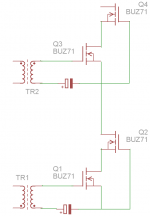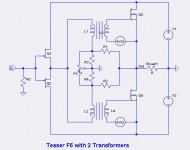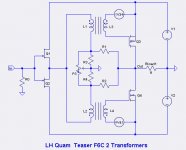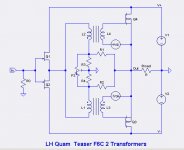The BA-3 front-end is really just a low power, open-loop variant of the F5. It is not a phase splitter, since a phase splitter generated both inverted and non-inverted signal outputs. Yes, the official F6 using only N-channel FETs requires a phase splitter.THe Jfet FE of BA3 FE is a unity gain phase splitter, sorta like a transformer. Well, if you split into two, that is what you have. Just ramblings of idle mind. I like The F6CC if it can retain the nature of F6 and improve performance.
If you are using reversed complementary fets on the minus side there is no actual need for the transformer.
You are re-reversing it
To be more in the spirir of F6 (same device symmetry etc) I would use the same cascode up and down and just connect rhe down part to the other transformer side
However the transformer feels a bit redundant if we use both complementary parts. It becomes more of a flavour than a practical element.
I do not understand wohat you are saying/asking. Can you provide a sketch of your idea?
Here is a sequence of F6 variants using 2 bifilar transformers and the feedback network modifies for nulling H2. The leftmost variant is the original F6 using only N-channel output FETs. The middle is a non-cascoded complementary variant. The rightmost is another non-cascoded complementary variant with output FETs swapped top-to-bottom. Yes, it looks like a complementary source-follower, but the voltages on the gates are relative to their source pins, not ground. Therefore it is a complementary common-source output stage. I am not sure why one would use this variant.
Attachments
If one of the transformer windings is flipped, that should work as a (non-complementary) cascoded F6. Generating the bais voltage for the upper cascode FET might be a little tricky, but not that different from the bias for the upper drive FET.
I didnt know how to put voltage source in the schematic, but this is general idea, I tihnk.
I think it would be difficult to overcome H2 in a cascoded F6.I was just tryign to illustrate an F6 with cascodes. Two transformers are shown, but they are intended as quadrifilar, as in the original F6.
There are two (or more) separate distortion mechanisms to consider.
- First is the output FET transconductance equation, which defines the drain current as a function of the gate voltage. Ignoring the internal source resistance, the equation is: Id = Kp/2*(Vgs - Vt)^2*(1+lambda*Vds). Cascoding causes the Vds term two be nearly constant, and the equation becomes mostly a quadratic function of gate voltage. This is good, because push-pull output stages can cancel the even order distortions.
- Second are the AC capacitances which cause frequency dependent currents in the circuit. Transformer winding capacitances are major contributor to the H2 distortions in the F6. In the F6, the upper secondary winding is connected to the output voltage, which injects a significant frequency dependent current into the other windings. The complementary version of the F6 significantly reduces the distortions due to the winding capacitances.
Yup, if the two halves are well matched, but it will not sound like an F6.Thank you for the very clear explanation. Would a balanced version be an opprotunity to cancel the 2nd harmonics generated in a standard F6 cascode?
Last edited:
I like this concept. We have a SE version of a cascoded F6, the F6CC, that accomplishes 2K cancellation and a balanced version that does the same thing. Parts count and simplicity clearly favor the F6CC, while true complimentary devices favor the balanced version. Thank you again. I may try this.
The thread "GC Supersymmetry" is an app for a balanced version. It will make an "F6CC Supersymmetry" amp.I like this concept. We have a SE version of a cascoded F6, the F6CC, that accomplishes 2K cancellation and a balanced version that does the same thing. Parts count and simplicity clearly favor the F6CC, while true complimentary devices favor the balanced version. Thank you again. I may try this.
What will it sound like? How would it be different from a balanced F5?The thread "GC Supersymmetry" is an app for a balanced version. It will make an "F6CC Supersymmetry" amp.

I like this. Your link doesnt work.What will it sound like?
Balanced amps of similar power utilizing SuperSymmetry may theoretically sound the same because of their vanishing THD. Fortunately. you have a standard balanced diy F5 in a small footprint and a stereo diy F6 to potentially addess your questions.What will it sound like? How would it be different from a balanced F5?

Once I test some more tweaks and figure out the limits of the F5CC, I think it will be a "tweakers delite". There are lots of adjustments available to modify H2 and H3. Depending on the available input voltage, the amount of feedback can be controlled by changing the feedback ratio (gain).
Here are some general observations from the various tests I have done:
Here are some general observations from the various tests I have done:
- No thermal runaway issues, because of the source resistors and stable bias circuits. The output voltage offset is stable after warmup.
- No problems with high frequency oscillation. On 50kHz square wave tests, without compensation caps across feedback resistors, there is overshoot; fixed with 10 nF caps.
- With 1000uF caps in the bias circuits, there might be some "breathing" at around 1/10 Hz. This may not be audible, but distortion tests show 50Hz H2 rising and falling at around -100dB at about that rate. I think that those caps can be reduced to 220uF or less without any lose in performance, and perhaps eliminating the "breathing".
A gift shows up - it is an F6
I am such a lucky boy. Nelson sent me an F6 to play with and enjoy.
Straight out of the box, it was very dull and lifeless. Realized that the transformer needed breaking in. 40 hours later it was ready for some listening.
The first impression of it is the magnificent soundstage. Instruments and people are located solidly in place, and the overall sound is one of precision. Everything is well controlled, delineated, and set on stage. When the power is just right (note to self: get power conditioner) and the lights are out, it gives a scary realistic "you are there" sound. Overall, rather hypnotic.
The leading edge of transients are slightly softened. Personally, I like this effect. It allows you to play more music. Slightly bad recordings are simply more listenable, and a touch on the soft side is always a lot better than a touch too hard.
It is harmonically very rich, and to my ears just slightly too rich. This is always preferable to being too dry. One of the real joys of Lowthers is that they are able to reproduce harmonics in a very natural way. Anything in front of the speaker that creates a dry sound is easily identifiable, and a problem. A few months ago I would have thought this richness to be a magnificent antidote for too-dry digital recordings, but my recently upgraded DAC is also harmonically rich. Nelson offered to dial this back a touch, as it is easily adjusted on the F6, but I think it will remain this way for awhile. It is extremely enjoyable just as she sits.
The interesting thing about this amp is how it invites listening at low levels. The SIT-1 is the opposite, it invites playing loudly. But with the F6 in the system, it gets played at low volumes late into the night. It is important to note that the SIT-1 can play softly, and the F6 can play loudly - neither mis-behaves under these conditions. In fact, the F6 can boogie with the extra wattage, and remains firmly in control when played loudly. Even with extended listening, there is nothing I can put my finger on as to why this preference exist, but I note it and it seems consistent. If you have a good theory as to why, please let me know.
I am such a lucky boy. Nelson sent me an F6 to play with and enjoy.
Straight out of the box, it was very dull and lifeless. Realized that the transformer needed breaking in. 40 hours later it was ready for some listening.
The first impression of it is the magnificent soundstage. Instruments and people are located solidly in place, and the overall sound is one of precision. Everything is well controlled, delineated, and set on stage. When the power is just right (note to self: get power conditioner) and the lights are out, it gives a scary realistic "you are there" sound. Overall, rather hypnotic.
The leading edge of transients are slightly softened. Personally, I like this effect. It allows you to play more music. Slightly bad recordings are simply more listenable, and a touch on the soft side is always a lot better than a touch too hard.
It is harmonically very rich, and to my ears just slightly too rich. This is always preferable to being too dry. One of the real joys of Lowthers is that they are able to reproduce harmonics in a very natural way. Anything in front of the speaker that creates a dry sound is easily identifiable, and a problem. A few months ago I would have thought this richness to be a magnificent antidote for too-dry digital recordings, but my recently upgraded DAC is also harmonically rich. Nelson offered to dial this back a touch, as it is easily adjusted on the F6, but I think it will remain this way for awhile. It is extremely enjoyable just as she sits.
The interesting thing about this amp is how it invites listening at low levels. The SIT-1 is the opposite, it invites playing loudly. But with the F6 in the system, it gets played at low volumes late into the night. It is important to note that the SIT-1 can play softly, and the F6 can play loudly - neither mis-behaves under these conditions. In fact, the F6 can boogie with the extra wattage, and remains firmly in control when played loudly. Even with extended listening, there is nothing I can put my finger on as to why this preference exist, but I note it and it seems consistent. If you have a good theory as to why, please let me know.
I am such a lucky boy. Nelson sent me an F6 to play with and enjoy.
Straight out of the box, it was very dull and lifeless. Realized that the transformer needed breaking in. 40 hours later it was ready for some listening.
The first impression of it is the magnificent soundstage. Instruments and people are located solidly in place, and the overall sound is one of precision. Everything is well controlled, delineated, and set on stage. When the power is just right (note to self: get power conditioner) and the lights are out, it gives a scary realistic "you are there" sound. Overall, rather hypnotic.
This is my chosen slant on amps, and this amp does it as well as any tube amp I have heard. I cannot wait to hear it through HE system, as this trait indeed shows itself most at low levels. Thank you gor the review.
Jon, thanks for the description/impressions.
Could your first sentence be the answer to your low-level impressions?
Kind of like the "loudness" setting in some receivers, the richness in sound levels at low-levels is nicely balanced out across frequencies at low-levels? The richness brings up the lows and highs at low-levels?
Just a thought.
Vince
It is harmonically very rich, and to my ears just slightly too rich.
Could your first sentence be the answer to your low-level impressions?
Kind of like the "loudness" setting in some receivers, the richness in sound levels at low-levels is nicely balanced out across frequencies at low-levels? The richness brings up the lows and highs at low-levels?
Just a thought.
Vince
- Home
- Amplifiers
- Pass Labs
- F6 Amplifier



